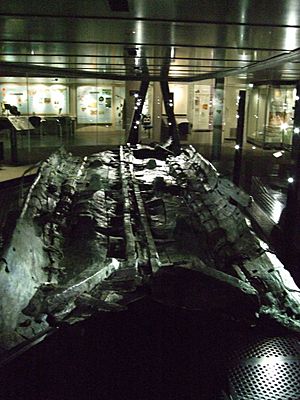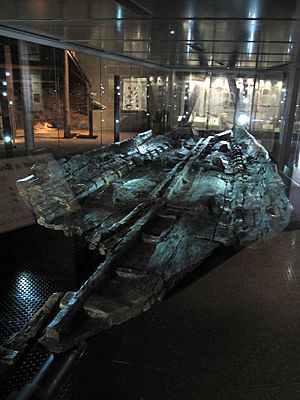Dover Bronze Age Boat facts for kids
The Dover Bronze Age boat is a very old boat found in England. It was built around 1575–1520 BC, which means it's about 3,500 years old! This makes it one of the oldest mostly complete boats ever found in the world. While some older ship pieces exist, they are usually much smaller fragments. The famous Khufu ship from Egypt is older (around 2500 BC), but it's a different type of boat.
The Dover boat was made from strong oak wood planks. These planks were "sewn" together using tough strips of yew wood. This way of building boats was common in Britain a very long time ago. Even older boats, like the narrower Ferriby Boats from Yorkshire, used a similar method. Today, a 9.5-meter (about 31-foot) part of the Dover boat is on display at the Dover Museum.
Contents
How the Boat Was Found
On September 28, 1992, something amazing happened in Dover. Workers were building a new road (the A20) and archaeologists from the Canterbury Archaeological Trust were watching closely. Suddenly, they uncovered parts of a huge, ancient boat! They quickly realized it was about 3,500 years old, from the Middle Bronze Age in England.
The boat was buried under the ground where the new road was being built. Part of it stretched under nearby buildings. Because it would have been too risky to dig near the buildings, some of the boat had to be left underground. In the past, trying to remove such old boats in one piece hadn't worked well. So, the team decided to carefully cut the boat into sections. This way, they could remove it safely and put it back together later. After almost a month of careful digging, they recovered 9.5 meters (about 31 feet) of the boat. This recovered part might be up to two-thirds of the boat's original full size.
Did It Sail the Seas?
The River Dour in Dover flows straight into the English Channel. This made people wonder if the Dover boat was used to sail across the Channel to mainland Europe. We know that people traveled between Britain and Europe during the Bronze Age, but we're not sure what kind of boats they used.
Some experts, like regional archaeologist Keith Miller, have suggested that the older Ferriby Boats from Yorkshire were used to cross the North Sea. The Ferriby Heritage Trust even calls one of the Ferriby boats "Europe's first known seacraft." A BBC show, Operation Stonehenge: What Lies Beneath Pt 2, also described the Ferriby boat as sea-going and able to carry tons of goods across the Channel.
However, the Dover Museum believes the Dover Bronze Age Boat is the oldest known sea-going boat, dating to 1550 BC. They are supported by another BBC program, A History of Ancient Britain, hosted by Neil Oliver. A Time Team Special also suggested that for a boat to be truly sea-going and able to cross the Channel, it would need a curved bottom (called a 'rocker') and a pointed front (bow). They claimed the Dover boat likely had these features. It can be a bit confusing because a modern copy of the Ferriby boats was given a pointed bow, and the museum housing the Ferriby boats says they also had curved bottoms, similar to the Dover boat.
About the Boat's Remains
We don't know much about how the boat was used because few clues were left with it. According to A History of Ancient Britain, the boat was carefully placed in a smaller channel off the River Dour while it was still in good condition. The yew stitches holding it together were deliberately cut, making it unusable. It was then quickly covered by silt (fine mud), which helped preserve it for thousands of years.
What Size Was It?
The part of the boat that was recovered is about 9.5 meters (31 feet) long and 2 meters (6.5 feet) wide. Since some of the boat is still underground and we don't know its exact original shape, people have guessed a lot about its total length and design. The museum shows different ideas, but the boat might be only a little longer than what was found, or it could have been many meters longer.
The boat's width is quite important. Being about 2 meters wide, it's much wider than most dugout canoes from that time. Two people could easily sit side-by-side in it. It's also wider than the Ferriby boats, for example.
How It Was Built
The Dover boat was built from strong oak planks. These planks were "stitched" together using flexible strips of yew wood. Wooden wedges were also hammered into special carved parts (called cleats) on the planks to hold them together. This building method is similar to the Ferriby boats, which also used stitched planks. However, it's quite different from the boats found at Must Farm Bronze Age settlement. Those were "dugout" canoes, meaning they were carved out of a single tree trunk. The smaller, lighter Must Farm boats were even made from lighter linden trees.
Keeping the Boat Safe
While the boat was buried, being waterlogged and covered in silt protected it from bacteria that would have destroyed it. After it was dug up, the boat was kept wet at the Mary Rose Trust in Portsmouth. This was part of a long process to preserve it. Finally, in 1998, the boat returned to the Dover Museum to be put back together.
The boat is now displayed in a large glass case. It's the main attraction on an entire floor of the museum dedicated to archaeology (the study of old things). Next to the original boat, there's a modern model of a section of the boat. This helps visitors understand how the ancient boat was built. The display even won an award in 2000 for its excellent archaeological presentation.
Building Copies of the Boat
First, a full-size, three-meter (10-foot) section of the boat was built. This was an experiment to learn about the ancient building techniques. This model is also at the Dover Museum, alongside the original boat.
The Ole Crumlin-Pederson Boat
Later, in 2012, a half-size copy of the Dover boat was finished in Dover. Because of time limits, modern materials like silicone sealant and modern ropes were used to put it together. When they tried to launch it, the boat took on a lot of water right away. However, this copy, first called BC 1550, has since traveled around the Channel area to different countries. It was later officially named after one of its builders, Ole Crumlin-Pederson.
The boat was then taken apart and rebuilt using only Bronze Age materials. They used moss mixed with animal fat to seal the gaps, and stitched the planks together with yew lashings, just like the original. This rebuilt boat has now been sailed out from Dover Harbour and was filmed for a Time Team Special on UK Channel 4.
Another almost full-size copy of a sewn plank boat was made at the National Maritime Museum Cornwall in 2012-2013. It was launched in March 2013 and sailed around Falmouth Harbour.





